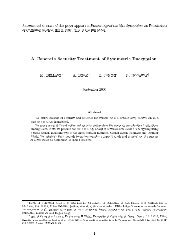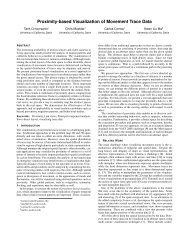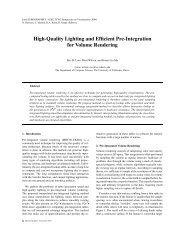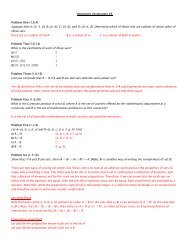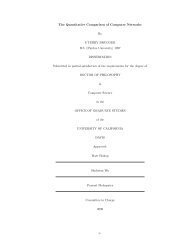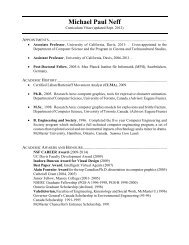An Enciphering Scheme Based on a Card Shuffle - Department of ...
An Enciphering Scheme Based on a Card Shuffle - Department of ...
An Enciphering Scheme Based on a Card Shuffle - Department of ...
You also want an ePaper? Increase the reach of your titles
YUMPU automatically turns print PDFs into web optimized ePapers that Google loves.
2 Viet Tung Hoang, Ben Morris, and Phillip Rogaway<br />
proc EKF (X) //swap-or-not<br />
for i ← 1tor do<br />
X ′ ← Ki ⊕ X<br />
ˆX ← max(X, X ′ )<br />
if Fi( ˆ X)=1thenX ← X ′<br />
return X<br />
Fig. 1. Cipher E =SN[r, n] encrypts X ∈{0, 1} n<br />
using a key KF naming K1,...,Kr ∈{0, 1} n and<br />
round functi<strong>on</strong>s F1,...,Fr : {0, 1} n →{0, 1}.<br />
C<strong>on</strong>structi<strong>on</strong>. Suppose we<br />
aim to encipher n-bit strings;<br />
our message space is the set<br />
X = {0, 1} n . Assume we will<br />
use r rounds, and that the<br />
blockcipher’s key KF names<br />
subkeys K1,...,Kr ∈{0, 1} n<br />
as well as round functi<strong>on</strong>s<br />
F1,...,Fr, each <strong>of</strong> which<br />
maps n-bits to a single bit, so<br />
Fi : {0, 1} n → {0, 1}. Then<br />
we encipher X ∈{0, 1} n as<br />
shown in Fig. 1. The reas<strong>on</strong> that this works, that <strong>on</strong>e gets a permutati<strong>on</strong>, is<br />
simply that X ↦→ Ki ⊕ X is an involuti<strong>on</strong>, and our round functi<strong>on</strong> depends <strong>on</strong><br />
the set {X, Ki ⊕ X}. The inverse directi<strong>on</strong> for swap-or-not is identical to the<br />
forward directi<strong>on</strong> shown above except for having i run from r down to 1.<br />
Restating the algorithm in English, at each round i we pair the current value<br />
<strong>of</strong> X ∈{0, 1} n with a “partner” point X ′ = Ki ⊕ X. We either replace X by<br />
its partner or leave it al<strong>on</strong>e. Which <strong>of</strong> these two things we do is determined<br />
by applying the boolean-valued Fi to the two-element set {X, X ′ }. Actually, in<br />
order to give Fi a more c<strong>on</strong>venti<strong>on</strong>al domain, we select a can<strong>on</strong>ical representative<br />
from {X, X ′ },say ˆ X =max(X, X ′ ), and apply Fi to it. Note that each plaintext<br />
maps to a ciphertext by xoring into it some subset <strong>of</strong> the subkeys {K1,...,Kr}.<br />
This might sound linear, but it most definitely is not.<br />
<strong>Card</strong> shuffling view. The swap-or-not c<strong>on</strong>structi<strong>on</strong> was invented, and will be<br />
analyzed, by regarding it as a way to shuffle a deck <strong>of</strong> cards. Seeing a blockcipher<br />
as a card shuffle enables <strong>on</strong>e to exploit a large body <strong>of</strong> mathematical techniques,<br />
these dating back to the first half <strong>of</strong> the twentieth century. In additi<strong>on</strong>, some<br />
ways to shuffle cards give rise to enciphering schemes that cryptographers did<br />
not c<strong>on</strong>sider. Swap-or-not is such a case.<br />
One can always see a card shuffle as an enciphering scheme, and vice versa.<br />
If you have some method to shuffle N cards, this determines a corresp<strong>on</strong>ding<br />
way to encipher N points: place a card at each positi<strong>on</strong> X ∈ [N], where [N] =<br />
{0, 1,...,N−1}; shuffle the deck; then look to see the positi<strong>on</strong> where the card<br />
initially at positi<strong>on</strong> X ended up. Call that positi<strong>on</strong> the ciphertext Y for X. The<br />
randomness used in the shuffle corresp<strong>on</strong>ds the cipher’s key.<br />
The first thing needed for a card shuffle to give rise to a computati<strong>on</strong>ally feasible<br />
blockcipher is that the shuffle be oblivious, an idea suggested by M<strong>on</strong>i Naor<br />
[18, p. 62], [23, p. 17]. In an oblivious shuffle <strong>on</strong>e can trace the trajectory <strong>of</strong><br />
a card without attending to lots <strong>of</strong> other cards in the deck. Most c<strong>on</strong>venti<strong>on</strong>al<br />
shuffles, such as the riffle shuffle, are not oblivious. The Thorp shuffle [26] is<br />
oblivious—and so is swap-or-not. As a shuffle, here’s how it looks.



